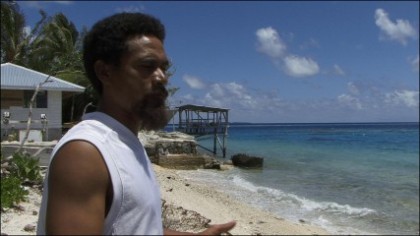June 4, 2010

Tokelau's atolls are vulnerable to cyclones and storms that are becoming more severe due to climate change. On Nukunonu Atoll, near the school playgrounds, the waves from Pacific storms have washed right over the top of the land. Photo by Selwyn Manning.
A claim by a scientist that some Pacific islands and atolls are growing in size rather than being eroded by climate change has been criticised by an Auckland-based Pacific photographer.
The claims suggest storm surges and severe cyclones that are linked to climate change are actually pushing coral up onto atolls and causing them to increase in size. The findings were published in New Scientist magazine and were co-written by Paul Kench of Auckland University’s School of Environment.
Click here for the New Zealand Herald’s report on this issue.
But the claims are being challenged by Auckland documentary photographer Jocelyn Carlin specialises in socially anthropologic images and has first hand exposure to Pacific people’s stories from Kiribati and Tuvalu.
Carlin believes the New Scientist report is a “one dimensional view” of the affect of climate change on the Pacific Islands by only measuring land mass.
The real impact, she says, is the seawater intrusion – that is, seawater coming up through the ground, especially during high spring tides and this is nothing to do with the atolls changing shape.
The following statement is from Auckland Festival of Photography. It details how you can also view Jocelyn Carlin’s work at Auckland’s Aotea Centre and titled: Talking Culture series showcasing Climate Change and Environmental Photography on World Environment Day.
Pacific Island photographer says “size doesn’t matter”
Press Release:
Auckland Festival of Photography
Auckland documentary photographer Jocelyn Carlin specialises in socially anthropologic images and has first hand exposure to Pacific people’s stories from Kiribati and Tuvalu.
Jocelyn responds to the research reported by Geography Associate Professor Paul Kench, in which he relies on aerial and satellite photography, saying she believes this is a one dimensional view of the affect of climate change on the Pacific Islands by only measuring land mass.
Jocelyn says “try telling the Pacific people their island is OK because it’s growing in land mass. This will conflict greatly with their reality when they are trying to cope with storms that coincide with spring tides and their fresh water supply is constantly compromised.”
Jocelyn maintains that while coral debris may increase island mass, the real issue is the majority of atolls are already suffering because of an extreme lack of fresh water because it is infiltrated by seawater, a condition that is exacerbated during drought. Kiribati has just come out of a three year drought and many of the islands are focussed on fresh water collection so they can survive.
The real impact, she says, is the seawater intrusion – that is, seawater coming up through the ground, especially during high spring tides and this is nothing to do with the atolls changing shape.
Jocelyn welcomes a debate with Dr Paul Kench as she says “it’s one thing to be photographing from satellites but my experience of the issues is different from living and working amongst the Pacific Island people. It paints another story of what it’s like to be actually living on vulnerable Pacific Islands that have changed considerably over the last 50 years so that now a lot of them are virtually uninhabitable to the indigenous people”.
Jocelyn is part of the Auckland Festival of Photography Talking Culture series showcasing Climate Change and Environmental Photography on World Environment Day.
|

